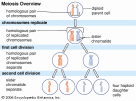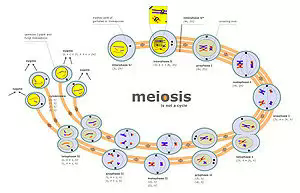Арсланова_Г_А_и_др_Essential_English_for_Biology_Students (1). Kazan federal university
 Скачать 7.01 Mb. Скачать 7.01 Mb.
|
4Text 2.2. Introduction To Cell Division■  Essential targets: Essential targets:By the end of this text you should be able to: ● describe the main stages of the cell cycle ● distinguish between mitosis and meiosis. Pre-reading ■ Working in pairs discuss these questions with your partner. Then scan the text to find the answers and compare them with your discussion. Is cell division essential to life? What is the basis of reproduction in every organism? What provides continuity between one generation of cells and the next? How many chromosomes does each human cell have? ■ Read the given text and make your essential assignments: One of the most important concepts in biology is that cells arise only by the division of existing cells. Cell division is essential to all life. It enables a multicellular organism to grow and to replace worn out or damaged cells. It is also the basis of reproduction in every organism. Cell division starts with the division of the nucleus. There are two forms of nuclear division: mitosis and meiosis. Chromosomes: carrying information Chromosomes are the structures that provide continuity between one generation of cells and the next. Their name comes from the Greek: chroma = coloured, soma = body, because of their affinity for certain stains used in microscopy. Chromosomes consist of DNA, the genetic material of the cell, wrapped in protein. They become visible in the nucleus where the more dispersed chromatin existed before. Whole chromosomes can be examined microscopically after breaking a dividing cell open and staining it with a suitable dye. Chromosomes form homologous pairs I  f the chromosomes are cut out they can be arranged into matching pairs according to their size and certain other features. These are called homologous pairs. Apart from the sex chromosomes, both chromosomes in a pair normally contain the same genes (for example, for eye or hair colour). However, these may be different forms of the gene (for example, one chromosome carries the form for green eyes, the other for brown eyes). Human cells each have 46 chromosomes (23 pairs). Other species have different numbers, for example, chimpanzee cells each have 48 (24 pairs) and cabbage plant cells each have 18 (9pairs). One chromosome in each pair comes from the individual’s mother and the other from the father. - Cells that have the normal two sets of chromosomes are called diploid. - Cells that give rise to gametes (eggs and sperm) have only one chromosome of each pair, so they have half the normal number of chromosomes. Such cells are called haploid. - In humans, n =23, so normal diploid cells have 46 chromosomes and the haploid gametes have 23 chromosomes. Mitosis: two identical daughter cells In mitosis, the nucleus divides once and produces two identical nuclei. The new daughter cells are genetically identical to the parental cell (unless their DNA has been changed in some way, for example by a mutation). So mitosis doubles the number of cells without changing the genetic information. New cells for growth of a multicellular organism, asexual reproduction, and wound healing, for example, are produced by mitosis. The cell cycle The cell cycle is the sequence of events that occurs between one cell division and the next. It consists of three main stages: 1. During interphase, the cell grows, carries out its functions, and replicates its DNA. After the DNA is replicated, new protein becomes attached to it. The chromosome now consists of two strands called sister chromatids which contain identical genetic information. Sister chromatids are joined at some point along their length by a centromere. These become visible under the light microscope only during mitosis. Typically, interphase lasts for about 90 per cent of the cell cycle. 2. Nuclear division takes place during mitosis. The chromatids containing replicated DNA are separated from each other and are redistributed as chromosomes in the nuclei of the two new daughter cells. 3. In cell division (also called cytokinesis) the cytoplasm divides to form two daughter cells. The duration of the cell cycle varies according to conditions such as temperature and the type of cell. The cell cycle of some plant cells (for example, stamen cells of Tradescantia) takes less than 30 minutes at 45°C, but more than two hours at 10°C. Cells in the growing root tip of an onion divide every 22 hours at 20°C. Some cells such as human nerve cells do not divide at all once they have become specialized. Meiosis: four different daughter cells I  n meiosis, the nucleus divides twice. This produces four haploid nuclei. The number of chromosomes is therefore halved during meiosis. Moreover, homologous chromosomes within a pair can exchange genetic material before being separated. The daughter cells are therefore genetically different from the parent cell (and from each other). n meiosis, the nucleus divides twice. This produces four haploid nuclei. The number of chromosomes is therefore halved during meiosis. Moreover, homologous chromosomes within a pair can exchange genetic material before being separated. The daughter cells are therefore genetically different from the parent cell (and from each other).Meiosis is the basis of sexual reproduction, occurring at some point in the life cycle of organisms that reproduce sexually. The haploid gametes produced by meiosis fuse during fertilization. This means that the new fertilized cell has the diploid number of chromosomes. Without meiosis in the life cycle, the number of chromosomes of a sexually reproducing species would be doubled in each generation. ■ Glossary of essential terms for you to know
■ Your Essential Assignments I. Quick check: 1. a) List the main stages of mitosis, starting with interphase. b) At which stage is DNA replicated? 2. Compare mitosis and meiosis in terms of number of cell divisions and number of daughter cells. II. Fill in the missing words:
III. Use monolingual English dictionary and write down what could the words given below mean: affinity, give rise to, division, asexual, generation. IV. Match these words with their definitions:
V. Find English equivalents to the following word combinations:
VI. Give Russian equivalents to the following English terms:
VII. Find synonyms among the pool of words:
VIII. Answer the following questions. Use all information given before. What enables a multicellular organism to grow and replace worn out or damaged cells? 2. What does cell division start with? 3. What two forms of nuclear division do you know? 4. What are chromosomes? 5. What do chromosomes consist of? 6. What is known as homologous pairs? 7. What is the difference between diploid and haploid? 8. What are three main stages of the cell cycle? 9. How does the duration of the cell cycle vary? IX. Match the sentence halves. Make complete sentences:
X. Read and translate the short text without any dictionary: Fact of life: Some laboratory-grown mammalian cells appear to obey an internal “biological clock” that allows them to divide by mitosis a maximum number of times. For example, a fibroblast (connective tissue cell) taken from a fetus divides on average about 50 times; the same type of cell taken from an adult divides only 14 to 19 times. XI. Food for thought:Although meiosis occurs at some stage in the life cycle of sexually reproducing plants, their gametes are usually formed by mitosis. Suggest reasons for this. |
